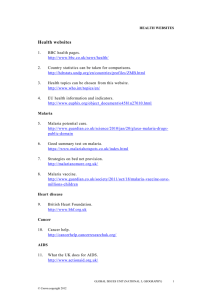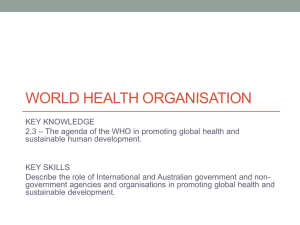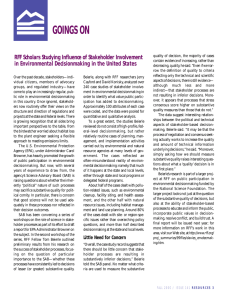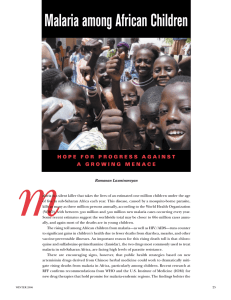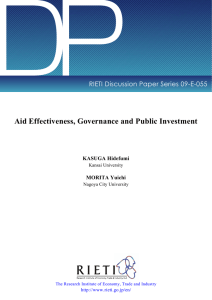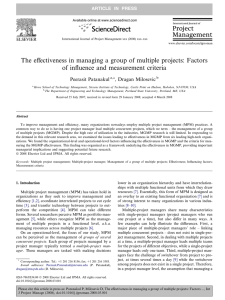T RFF and Human Health
advertisement
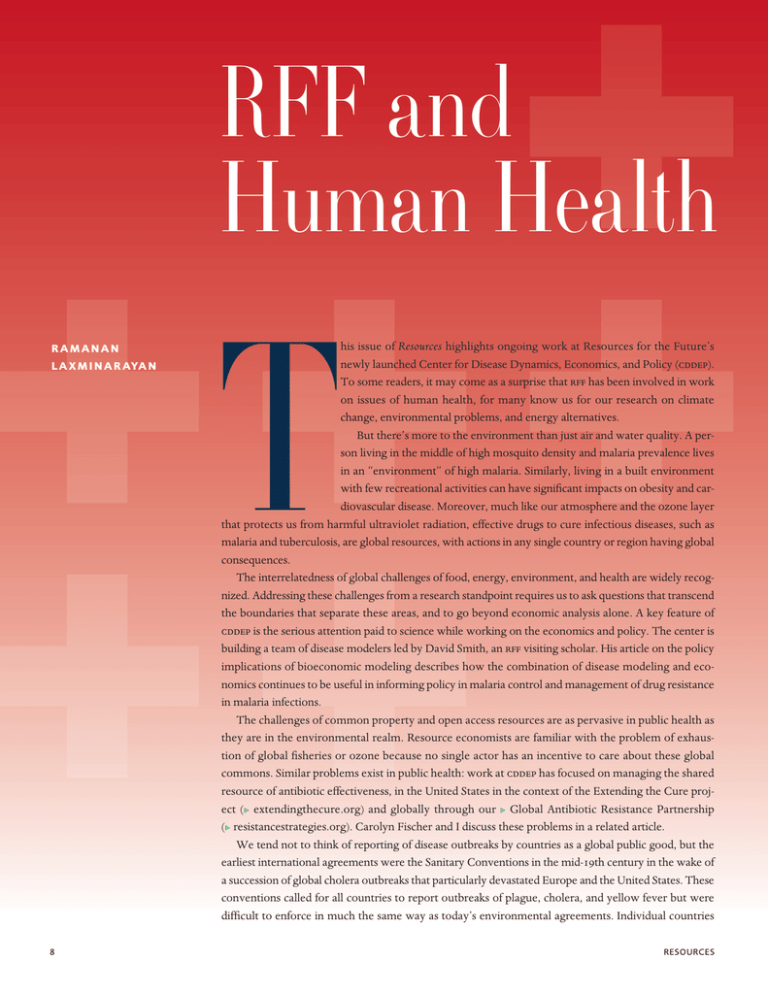
RFF and Human Health RAMANAN LAXMINARAYAN 8 T his issue of Resources highlights ongoing work at Resources for the Future’s newly launched Center for Disease Dynamics, Economics, and Policy (CDDEP). To some readers, it may come as a surprise that RFF has been involved in work on issues of human health, for many know us for our research on climate change, environmental problems, and energy alternatives. But there’s more to the environment than just air and water quality. A person living in the middle of high mosquito density and malaria prevalence lives in an “environment” of high malaria. Similarly, living in a built environment with few recreational activities can have significant impacts on obesity and cardiovascular disease. Moreover, much like our atmosphere and the ozone layer that protects us from harmful ultraviolet radiation, effective drugs to cure infectious diseases, such as malaria and tuberculosis, are global resources, with actions in any single country or region having global consequences. The interrelatedness of global challenges of food, energy, environment, and health are widely recognized. Addressing these challenges from a research standpoint requires us to ask questions that transcend the boundaries that separate these areas, and to go beyond economic analysis alone. A key feature of CDDEP is the serious attention paid to science while working on the economics and policy. The center is building a team of disease modelers led by David Smith, an RFF visiting scholar. His article on the policy implications of bioeconomic modeling describes how the combination of disease modeling and economics continues to be useful in informing policy in malaria control and management of drug resistance in malaria infections. The challenges of common property and open access resources are as pervasive in public health as they are in the environmental realm. Resource economists are familiar with the problem of exhaustion of global fisheries or ozone because no single actor has an incentive to care about these global commons. Similar problems exist in public health: work at CDDEP has focused on managing the shared resource of antibiotic effectiveness, in the United States in the context of the Extending the Cure project († extendingthecure.org) and globally through our † Global Antibiotic Resistance Partnership († resistancestrategies.org). Carolyn Fischer and I discuss these problems in a related article. We tend not to think of reporting of disease outbreaks by countries as a global public good, but the earliest international agreements were the Sanitary Conventions in the mid-19th century in the wake of a succession of global cholera outbreaks that particularly devastated Europe and the United States. These conventions called for all countries to report outbreaks of plague, cholera, and yellow fever but were difficult to enforce in much the same way as today’s environmental agreements. Individual countries RESOURCES that reported an outbreak would face trade and economic sanctions and therefore had every incentive to remain quiet. Anup Malani and I discuss incentives for countries to look for and report disease outbreaks as a means to control epidemics in another article. Not all our work is on infectious diseases; after all, externalities are a problem in the case of alcohol and tobacco as well. When individuals choose to drink and drive or smoke in the presence of others, they impose costs for which they do not bear the consequences. In an article on optimal alcohol taxes, Ian Parry discusses the relative importance of various sources of economic costs associated with alcohol consumption. Finally, CDDEP researchers are continuing our long tradition of work on environment and health in China, an example of which is the article by Maureen Cropper. She develops careful estimates of the impact of air pollution on human health and the associated economic consequences, all of which are central to determining what level of effort China should put into controlling emissions. Of course, the ultimate goal of all CDDEP’s research is improved policy. The center’s team of economists, epidemiologists, disease modelers, and policy analysts has played a key role in the establishment of the † Affordable Medicines Facility–malaria (AMFm), a novel financing mechanism for lowering the cost of effective antimalarials in endemic countries and decreasing the likelihood that resistance to the anchor drug will emerge. The † Extending the Cure report has informed legislative efforts at both state and federal levels in the United States to improve infection control in hospitals and manage antibiotic effectiveness as a shared societal resource. And work on the † Disease Control Priorities Project (dcp2.org) has influenced changes in tobacco policy in Kenya and health priority setting in India. You may sign up for updates and follow our work at † cddep.rff.org. We also look forward to hearing from you. FALL 2009 9

